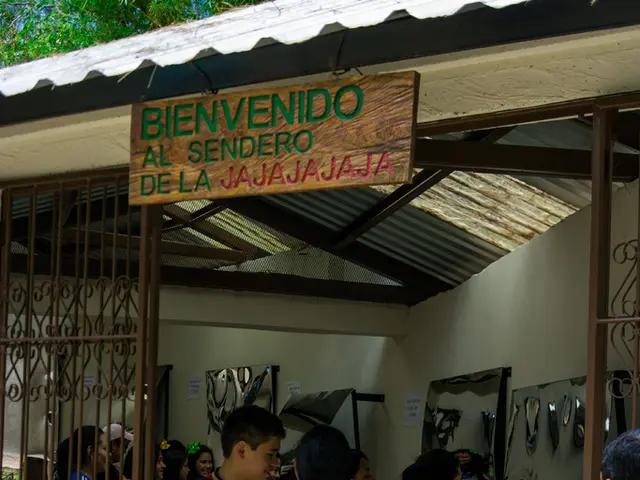Surviving the Solar Crunch: Adapting to New Rules for Photovoltaic System Owners in Germany
Duty of Photovoltaic System Owners: An Examination
Generating solar power just got a tad trickier for private system owners in Germany, thanks to the new Solar Peak Act. Here's what you need to know to keep your power plants humming and your bank account blooming.
It's no secret that solar power generation relies on a slew of factors, from the weather to the position of the sun. But in Germany, a whole lot of electricity has been popping out at midday, occasionally overloading the power grid. To quell the chaos, the ex-government drafted the Solar Peak Act, which went into effect in early 2025. The goal? To even out solar power distribution, nixing those pesky midday "power peaks."
At its heart, the law says that new systems sporting a 7kW capacity or higher can only pump power into the grid unhindered if they're armed with an intelligent metering system (iMSys) and a technical control device. For systems under 7kW, the limit's forever, regardless of add-ons.
Spreading the Solar Love
But even with an intelligent metering system, bigger systems (2kW or more) won't rake in feed-in compensation if wholesale electricity prices nosedive. This phenomenon tends to happen when too much solar power floods the market and buyers are scarce. Last year, this happened for roughly 500 hours out of approximately 1,600 sunny hours. The lost compensation will be paid out over the previous 20-year compensation period, but with a time lag of two decades.
This regulation's primary aim is to rein in feed-in during high-stress network situations and prod system owners to consume or store their power and dish it out later, post sunset.
Solar Snarks Speak Up
The German Solar Energy Association (SFV) isn't exactly bowing in praise. Professor Dr. Frank Hergert, member of the SFV board and a University of Koblenz professor, critiques the new regulations in an analysis. He argues that the 60 percent power limitation — sans control technology —could result in significant energy waste and that said cap applies even in the absence of local network overloads. Instead of relying on local network conditions, the new rules rely on market signals like wholesale electricity prices.
Hergert also doesn't sugarcoat the fact that operators of smaller systems without smart meter infrastructure will be hard-pressed economically in the future. Self-consumption and battery storage can offset losses, but these investments might not be feasible or profitable for all homeowners. The SFV thinks that the new law could hamper the decentralized expansion of solar power, a cornerstone of the energy transition. Rather than fostering simple solar systems, the law erects barriers to market entry due to technical requirements and economic uncertainties.
But, some industry giants see silver linings in the new regulated remuneration. Oliver Koch, CEO of Sonnen (an Allgäu-based firm producing intelligent storage systems), says, "The new law rewards timely power feeding, not just volume. For households, smart energy management and a storage system are now a must-have, as those who neglect them will lose money."
Calculations by the company suggest that the abolition of remuneration through negative prices is more painful, with a 25 percent drop in income, than the cap on feed-in, which takes a bite out of income by roughly 8 percent (according to the SFV). According to Koch, the former can be mitigated via "direct marketing" of surplus solar power, which can be sold when prices are peak, not when they plummet. This strategy's coupled with prognosis-based battery charging based on weather predictions and the like, ensuring batteries don't start charging in the morning, but only when the 60 percent threshold's exceeded.
Brain Food for PV System Owners
Bonus Tip: If you're planning to throw your system into action after the cut-off date of 25 February 2025, try to install an intelligent measuring system (iMSys) with control equipment. Doing so will help skirt the 60 percent power feed limit, securing remuneration even at full solar yield, albeit at an additional expense for PV system owners.
Investing in a battery storage system can boost self-consumption and curb yield losses due to feed-in limitations. If it's intelligent and ability-based, it can largely make up for the 60 percent rule. Homeowners are best advised to consult an installer on whether a storage system makes financial sense for them.
Systems boasting a peak power of up to seven kW aren't yet compelled to install control technology, but they're susceptible to the dumping of feed-in remuneration during times of negative market prices. They're whittled down to 60 percent of their feed-in power regardless of whether they install an intelligent measuring system.
Bonus Tip: If you've installed your system before the cut-off date, you've got nothing to worry about—your existing remuneration schemes and technical conditions hold strong. However, these systems will get an intelligent measuring system and a control device at seven kW and above at some point. Besides, installing a storage system or energy management systems could prove beneficial if you're aiming to optimize self-consumption or integrate new consumption devices like wall boxes.
- The community policy should include guidelines for the installation and operation of intelligent metering systems and control devices for photovoltaic systems, to ensure compliance with the Solar Peak Act and maximize feed-in compensation.
- The employment policy should encourage the development and implementation of renewable energy technologies, such as solar power, by providing incentives for research and development in the fields of science, finance, and technology, to bolster the energy transition and foster the growth of the renewable energy sector.




